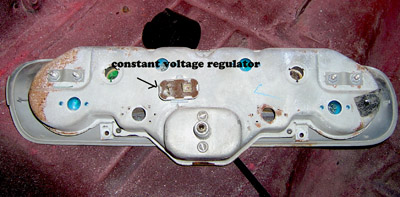1965 Mustang Gauge Wiring Problem
by Arlie Robinson
(McKinney, Texas)
Question: My 1965 Mustang has 1966 instrument (gas,oil,amp,and temp) gauges.
I took it into a custom rod shop because the gauges did not work. Long story made short.
I spent $3,200 to have a Painless wiring harness and a new instrument voltage regulator installed.
I got just a few miles away from the shop and the gauges went dead again.
The rod shop said that I needed a stronger dash regulator. I have not been able to find anything to replace it.
Any help would be appreciated.
Answer: Ouch ! Two grand plus, to install a $ 600 wiring harness.
It's hard to diagnose an electrical issue without more discussion, but here's what I'd suggest.
I've never heard of having to use a "stronger" regulator. The stock regulator is the same piece for both the 65 and 66 cars and for cars with idiot lights or gauges.
You may have a short or an open in your gauge pod wiring, a blown fuse, a bad ground, a bad gauge voltage regulator, or the regulator is incorrectly wired.
Unless you have a digital volt-ohmmeter, or a friend who does, I'd be tempted to tell you to risk a new voltage regulator and see whether you have working gauges. But here's a way you can test the one on the gauge pod.
See if you can unscrew the gauge pod and pull it forward to reveal the wires. The regulator is the little metal box attached to the back of the panel. It's job is to convert the system's 12 volts to just 5 volts to power the gauges.
One wire is the 12 volt feed from the battery. There should also be a connection to ground and a voltage out wire. The voltage out wire should be sending a pulsing voltage (5 volts) to the gauges.
If you have no voltmeter you can still test it.
Turn the ignition on. You can test the output with a test light. You should have a pulsing light ( or pulsing voltage with a meter ).
If it's not pulsing, it's not working. Clean off the ground connection and try it again. If it's still no go, I'd try a new gauge voltage regulator.
It's unlikely, if not impossible that all the gauges are dead, so the source voltage or lack of it, is the problem.
Note: if the wiring to the gauges is still original, the color, should be black/green. You'll notice one of these wires to each gauge.
Comments for 1965 Mustang Gauge Wiring Problem
|
||
|
||
|
||
|
||
|
||
|
Click here to add your own comments Join in and write your own page! It's easy to do. How? Simply click here to return to Contact Me !. |
